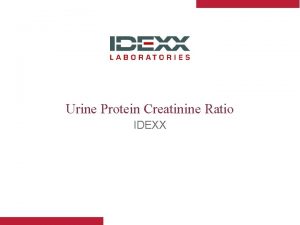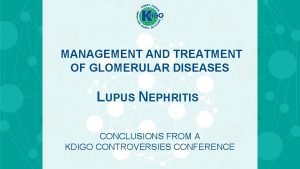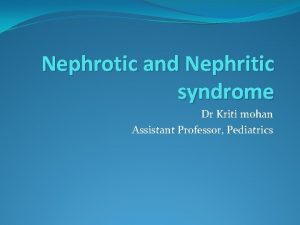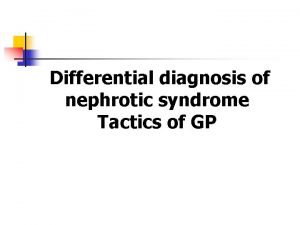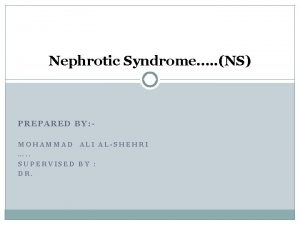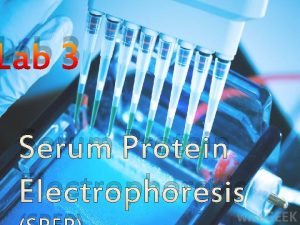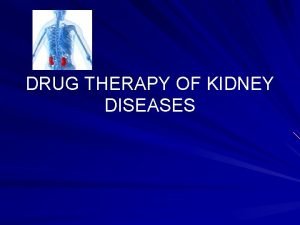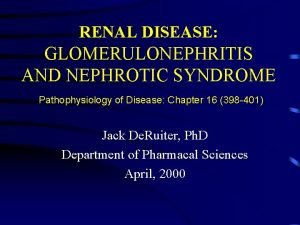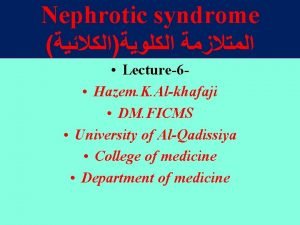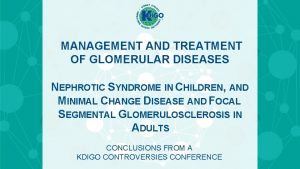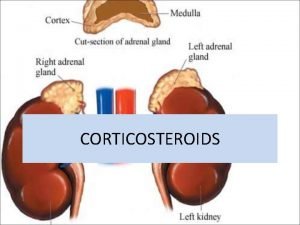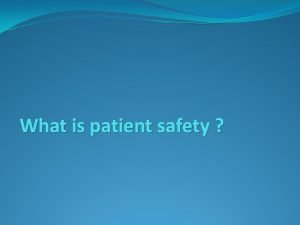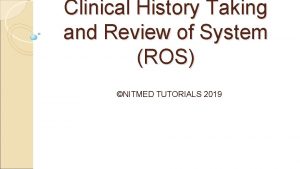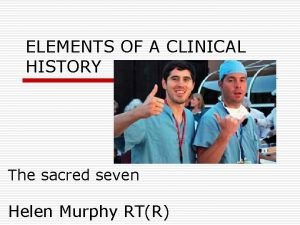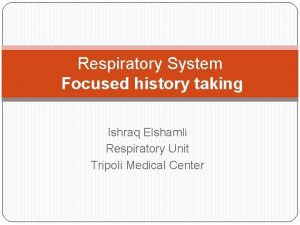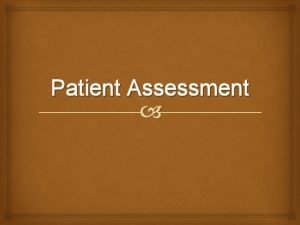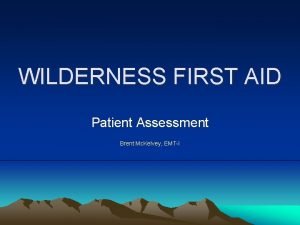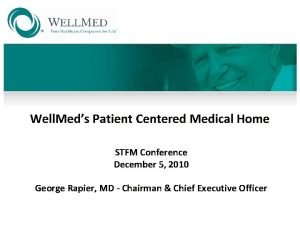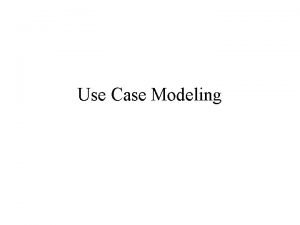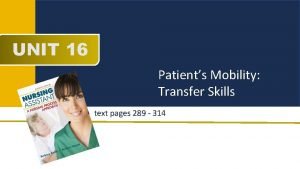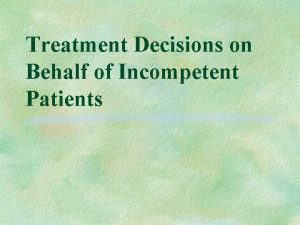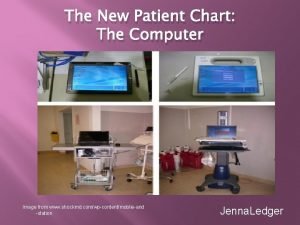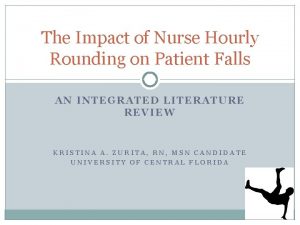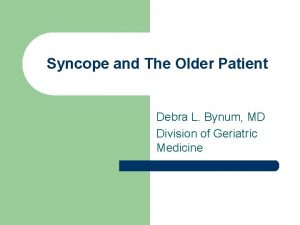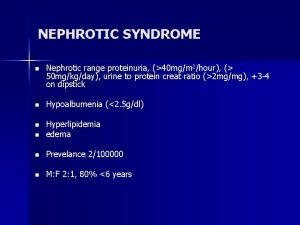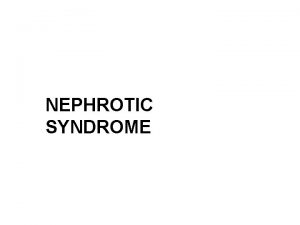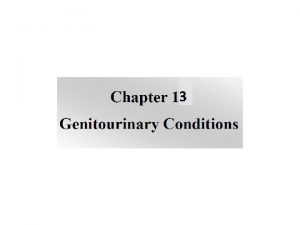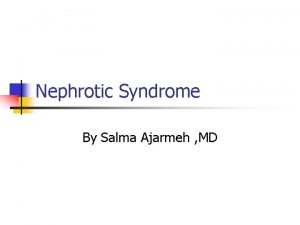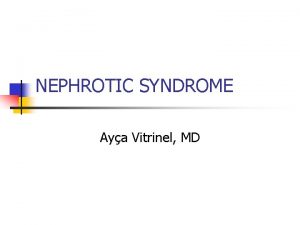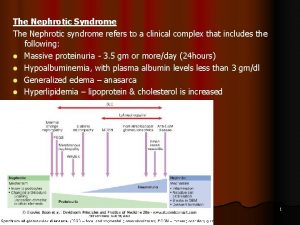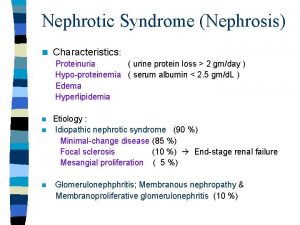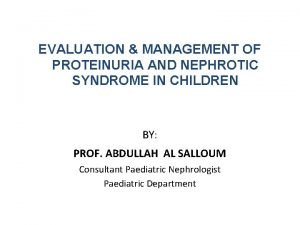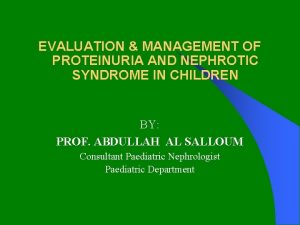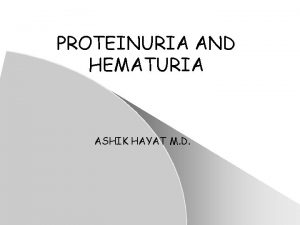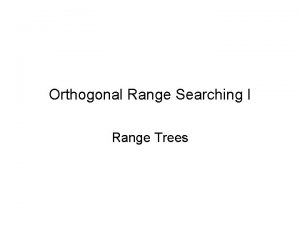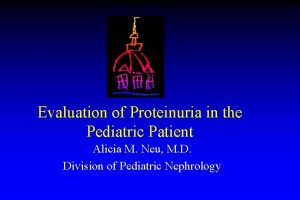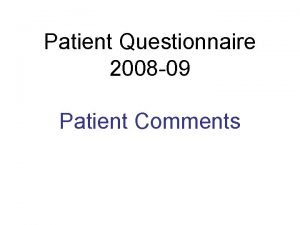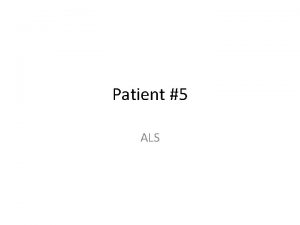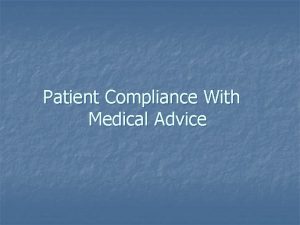Patient 11 m with nephrotic range proteinuria History








































- Slides: 40

Patient 11 m with nephrotic range proteinuria

History • 11 M with nephrotic range proteinuria – U P/C 7 • Microscopic hematuria




Alpha-1 Chain of Type IV Collagen CONTROL Alpha-1 Chain of Type IV Collagen Patient

Alpha-5 Chain of Type IV Collagen CONTROL Bowman’s Capsule Positive Alpha-5 Chain of Type IV Collagen Patient Occasional TBM Positive

Alpha-3 Chain of Type IV Collagen CONTROL Alpha-3 Chain of Type IV Collagen Patient

Immunofluorescence • Routine IF Negative for Ig’s and Complement • Alport’s Panel – Controls all positive – Negative for Alpha 3 and Alpha 5 in glomeruli – Positive for Alpha 5 in Bowman’s Capsule and some TBMs





Electron Microscopy • Lamellation, thickening and thinning of GBMs

Diagnosis • Findings c/w Alport’s Syndrome, Autosomal Recessive Type • Mild Interstitial Fibrosis

Skin Biopsy to Confirm • The family history did NOT conform to an autosomal recessive pattern • A skin biopsy can be very helpful in that alpha 5 is not altered in typical Autosomal Recessive Alport’s Syndrome

Alpha-1 Alpha-5

Alpha-1

Alpha-5

Alpha-3

Skin Bx IF • Alpha-1 is Positive • Alpha-5 is Negative – The Type IV Collagen of Skin is composed of Alpha 1, 1, 2 and Alpha 5, 5, 6 – There is NO Alpha-3 (so the Alpha-3 is a negative control in this case)

Diagnosis • Likely X-Linked Alport’s Syndrome, though the data is somewhat conflicting • Lets review and come back to the final dx at the end.

Alport’s Syndrome • Recurrent hematuria • Nerve deafness • Usually presents in early 20’s • Classic renal biopsy features by EM – Thickened and Thinned GBM – Lamination and Rarefaction – Grains

Alport’s Syndrome • Frequency ~ 1: 5000 • Accounts for 1 -2% of ESRD in the US, Europe and India • Genetics were unclear until very recently – Strict inclusion criteria not used

Alport’s Syndrome • Genetics – X-Linked (80 -85%) – Autosomal Recessive (10 -15%) – Autosomal Dominant (very rare) – Spontaneous mutations (10 -15%)

Alport’s Syndrome • Pathogenesis – Genetic abnormality of type IV collagen – Each family has its own mutation – Hundreds of genetic variants all developing Alport’s syndrome

Alport’s Syndrome • Type IV collagen – Multimeric protein – Three alpha chain monomers coil in a triple helix to form a protomer • Each monomer is a very large protein with an even larger gene – 6 alpha chains of type IV collagen are known to exist – But only three are known to be expressed in protomers

Not All Combinations Exist • Type IV collagen – Alpha 1, Alpha 2 – Alpha 3, Alpha 4, Alpha 5 – Alpha 5, Alpha 6 – Two protomers combine to form a dimer – Known products • Alpha 1, 1, 2 with Alpha 1, 1, 2 • Alpha 3, 4, 5 with Alpha 3, 4, 5 • Alpha 1, 1, 2 with Alpha 5, 5, 6 All Basement Membranes GBM, Eye, Cochlea Epidermis, Bowmans Capsule

Type IV Collagen Composed of Alpha Chains NOT Beta Pleated Sheets Protomers are Triple Helices

These Combinations Form Basement Membrane Mats These Mats Incorporate Many Other Important Molecules e. g. Laminin, Entactin, et al

Alport’s Panel in Kidney Biopsy • Stain for a-1, a-3 and a-5 Chains of Type IV Collagen – a-1 ALL Basement Membranes and Mesangial Matrix – a-3 GBM, BCBM and DTBM – a-5 GBM, BCBM, DTBM and Epidermal BM • a-5 is Key to differentiating the forms of Alport’s BCBM = Bowman’s Capsule Basement Membrane DTBM = Distal Tubule Basement Membrane

Alport’s Syndrome • Type IV collagen – Known products • Alpha 1, 1, 2 with Alpha 1, 1, 2 ALL BMs & Mesangial Matrix • Alpha 3, 4, 5 with Alpha 3, 4, 5 GBM, BCBM, DTBM • Alpha 1, 1, 2 with Alpha 5, 5, 6 Epidermis, BCBM, DTBM BCBM = Bowman’s Capsule Basement Membrane DTBM = Distal Tubule Basement Membrane BM = Basement Membrane

Genetic Types of Alport’s • X-Linked (80 -85%) • Autosomal Recessive (10 -15%) • Autosomal Dominant (very rare) • Spontaneous mutations (10 -15%)

X-Linked – Alport’s Panel • Abnormality in alpha-5 so skin and kidney analysis of collagen subunits can be tested – Absence of staining for alpha-5 in glomerular, capsular and distal tubular basement membranes in Males – Discontinuous staining for alpha-5 in glomerular, capsular and distal tubular basement membranes in Females • Alpha-3 is also missing in a similar fashion since there is no alpha-5 to work with • Abnormalities seen in only 2/3 of patients!

Autosomal Recessive – Alport’s Panel • Abnormality in alpha-3 or alpha-4 – Absence of staining for alpha-5 in glomerular basement membranes, persistence in capsular and distal tubular basement membranes – Alpha-5 positive in epidermis because that collagen is made of Alpha 1, 1, 2 with Alpha 5, 5, 6 – no alpha-3 or -4 – So Skin examination alone will be normal and not reveal the Alports phenotype • Abnormalities of kidney seen in ‘most’ patients!

Alport’s Syndrome: Is Diagnosis Only Skin-Deep? • Skin biopsy in suspected cases is an excellent first step if … • Quality laboratory with experience – Interpreting skin IF for Alport’s is NOT trivial Kashtan CE, Kidney Int 55: 1575 -1576, 1999

Alport’s Syndrome • Skin Bx to rule in Alports Stain with Anti-a 5 of Type IV Collagen § Absent – Alport’s Syndrome § Segmental – Alport’s carrier § Positive – Cannot absolutely R/O Because. . . • Skin stains for a 5 in Autosomal Recessive Alport’s

Final Diagnosis • The kidney findings support Autosomal Recessive (abnormalities of Alpha-3 and/or Alpha-4) in that there is absence of 5 in GBM but presence of 5 in BCBM and DTBM – Alpha 3, 4, 5 with Alpha 3, 4, 5 GBM, BCBM, DTBM – Alpha 1, 1, 2 with Alpha 5, 5, 6 Epidermis, BCBM, DTBM

Final Diagnosis • The skin findings support X-Linked Alport’s Syndrome (abnormalities of alpha-5) in that there is absence of Alpha-5 and presence of Alpha-1 in Epidermis – Alpha 3, 4, 5 with Alpha 3, 4, 5 GBM, BCBM, DTBM – Alpha 1, 1, 2 with Alpha 5, 5, 6 Epidermis, BCBM, DTBM

Final Diagnosis • Changes c/w Alport’s • Dr. Bell Talked with Dr. Cliff Kashtan at the University of Minnesota – Never seen a case like this – Suggested Athena Diagnostics for genetic testing
 Creatinine idexx
Creatinine idexx Overflow proteinuria
Overflow proteinuria Prerenal proteinuria
Prerenal proteinuria Prerenal proteinuria
Prerenal proteinuria Proteinuria
Proteinuria Fenestras
Fenestras Dr kirti mohan
Dr kirti mohan Nephrotic syndrome differential diagnosis
Nephrotic syndrome differential diagnosis Why there is hyperlipidemia in nephrotic syndrome
Why there is hyperlipidemia in nephrotic syndrome Dr shahzad ahmad
Dr shahzad ahmad Protein electrophoresis interpretation
Protein electrophoresis interpretation Primary and secondary causes of nephrotic syndrome
Primary and secondary causes of nephrotic syndrome Acute glomerulonephritis causes
Acute glomerulonephritis causes Nephrotic syndrome
Nephrotic syndrome Nephrotic syndrome in child
Nephrotic syndrome in child Corticosteroid classification
Corticosteroid classification Nephrotic syndrome criteria
Nephrotic syndrome criteria Nursing diagnosis for nephrotic syndrome slideshare
Nursing diagnosis for nephrotic syndrome slideshare Patient 2 patient
Patient 2 patient As compared to long-range forecasts, short-range forecasts
As compared to long-range forecasts, short-range forecasts Patient safety definition
Patient safety definition Haemotypsis
Haemotypsis Anamnesis 7 sacred
Anamnesis 7 sacred Past medical history
Past medical history History taking of patient
History taking of patient History taking of patient
History taking of patient Also history physical
Also history physical Case of kf
Case of kf Wilderness first aid patient assessment form
Wilderness first aid patient assessment form Patient centered medical home conference
Patient centered medical home conference Case scenario examples
Case scenario examples Maintenance of reports and records
Maintenance of reports and records Unit 16 the patient's mobility transfer skills
Unit 16 the patient's mobility transfer skills Hm life insurance company
Hm life insurance company Incompetent patient
Incompetent patient Transforming patient experience
Transforming patient experience Computerized patient chart
Computerized patient chart Hourly rounding and patient falls
Hourly rounding and patient falls Dr patient relationship ethics
Dr patient relationship ethics Syncope in the older patient is
Syncope in the older patient is Functional nursing definition
Functional nursing definition
